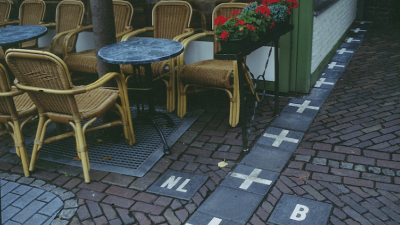The 18 most mysterious objects in the world
|
NEWS
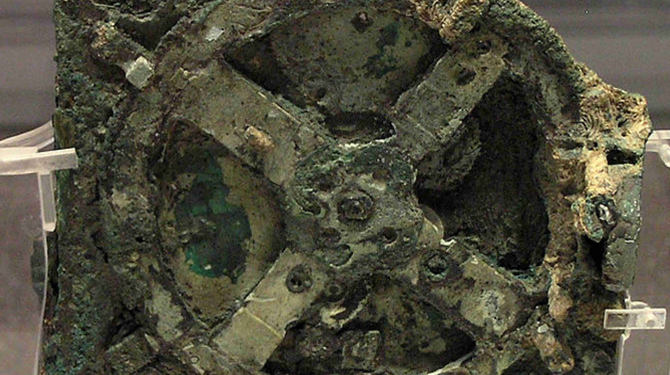
Source: listas.20minutos.es
OOPArt is the acronym in English of Out of Place Artifact (literally, 'artefacto out of place'). It is a term coined by the American naturalist and cryptozoologist Ivan T. Sanderson to name an object of historical, archaeological or paleontological interest that is found in a very unusual or apparently impossible context that could challenge the chronology of conventional history. This term is rarely used by leading historians or scientists. Its use is largely limited to cryptozoologists, the defenders of the Theory of Ancient Astronauts, creationists of the Young Earth and enthusiasts of the paranormal. The term is used to describe a wide variety of objects, from anomalies studied by conventional science to pseudoarchaeology far from being conventional, even for objects that have been proven to be deceptive or have mundane explanations. Critics argue that OOPArts that are not cheating are the result of a misinterpretation, an illusion, or a mistaken belief that a particular culture could not have created an artifact or technology due to lack of knowledge or materials. Followers consider OOPArts as proof that conventional science is neglecting large areas of knowledge, either voluntarily or out of ignorance.
TOP 18:
Coso artifact
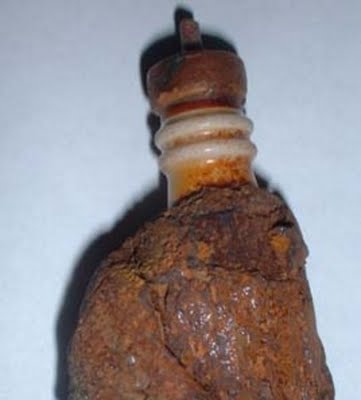
It is, apparently, a spark plug found inside a piece of clay on February 13, 1961 by Wallace Lane, Virginia Maxey and Mike Mikesell while searching for geodes near the town of Olancha, California. Mikesell found him breaking a rock in two. Virginia Maxey speculated at different times that this object was 100 or 500,000 years old as indicated by Stromberg and Heinrich (2000, 2004). Maxey could not provide information on the dating technique used or any evidence to calculate his age. The date of 500,000 years is only based on the opinion of an anonymous "geologist" named by the people who discovered this object. Nor is the identity, credentials, or specialty of the person who named this "geologist" known.
TOP 17:
Bird of Saqqara
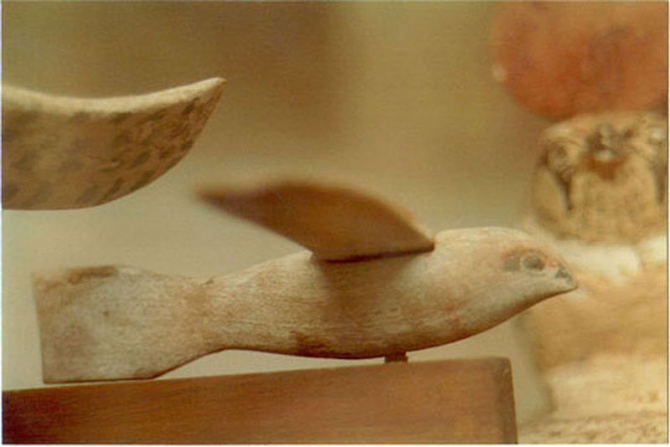
The Saqqara Bird is an object carved in sycamore wood, found in 1891 in the tomb of Pa-di-Imen, in the ancient Egyptian necropolis of Saqqara, which resembles an aerodynamic airplane in miniature. It dates from 200 a. C. approximately, and is in the Egyptian museum of Cairo. It measures 15 cm, with a wingspan of 18.30 cm. and it weighs 39 grams. It has a beak, holes for feathers, eyes, and was originally painted to resemble a hawk, with images and carvings representing wing feathers. By its curious form there are those who consider that it could be a plane model.
TOP 16:
Wolfsegg Iron
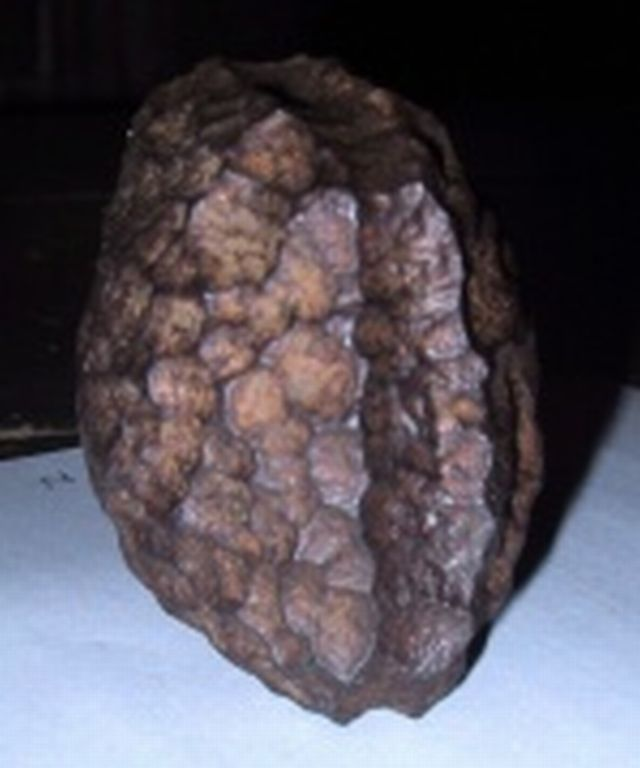
It is an interesting object, because its origin is a mystery. It has sometimes been adduced as proof that there existed, in prehistoric times, civilizations that surpassed the modern human race in technological development. A report that appeared in the scientific journal Nature (volume 35, 11, November 1886) describes the object as "almost a cube", "with a deep incision". The Iron of Wolfsegg was examined in 1966 at the Museum of Natural History in Vienna. The final opinion of Doctor Kurat of the Museum and the committee of the Geologisches Bundesanstalt in Vienna is that the object is simply artificial cast iron. It could be that such iron objects were used as ballast in primitive mining machinery. However, there is no evidence that such iron blocks were manufactured for mining.
TOP 15:
Metal spheres from Klerksdorp
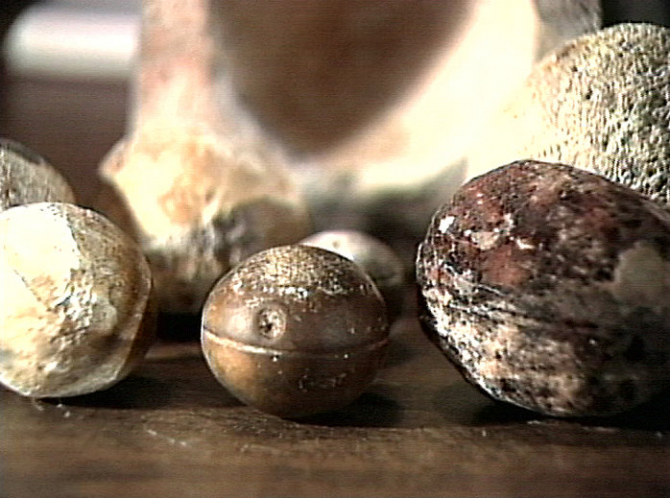
They are balls of pyrite that have been found in Ottosdal (South Africa) on Precambrian strata from 2,800 million years ago by miners. They are currently exhibited in the Klerkdorp museum. It is said that its spherical shape and fine grooves can only have come from intelligent beings. This point of view is included in the work Arqueología prohibida by Michael Cremo. It is not ruled out that its origin is natural.
TOP 14:
Magna Fountain
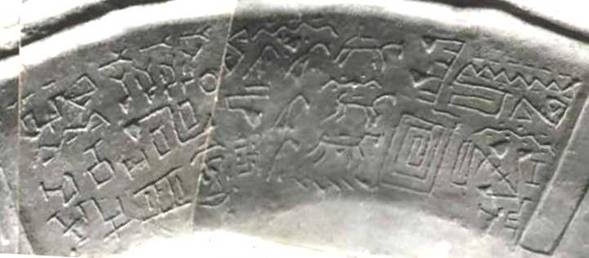
Magna Fountain, also known as Fountain Glass. It was discovered in Bolivia on the shores of Lake Titicaca by a local farmer. It is stated that some parts of the vessel would be written in Sumerian cuneiform characters, protosumerios and Mesopotamian semites. It is a large piece, similar to a glass for libations, probably used during religious ceremonies. It was found in 1950 by a farmer near the town of Chua, near Lake Titicaca. He is currently in a small museum on Jaén Street, La Paz, in Bolivia: Precious Metal Museum "Museo de Oro".
TOP 13:
Dogū
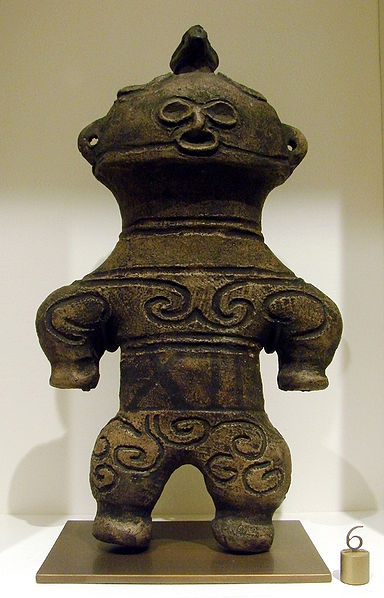
They are figures of animals and small humanoids made at the end of the Jōmon period (14,000 -400 BCE) of the prehistory of Japan. Most figures of humanoids have breasts, small waist and wide hips of women and are considered by many as representative of the goddesses. Many have a large abdomen associated with pregnancy, suggesting that the Jomon considered them as Goddesses Mothers. According to the Metropolitan Museum of Art, these figures "suggest an association with fertility and shamanic rites." Made of clay, these figures were forming fascinating forms. The Dogu tend to have large faces, small arms, hands and compact body. Some seem to wear glasses, or have "heart-shaped" faces. Most have marks on their faces, chests and shoulders, suggesting they had tattoos and the probable incision with bamboo. Dogus come from the Jōmon period and does not continue with the Yayoi period. As for the Jomon pottery, Dogu has various styles of the area and the generation of exhumation. According to the National Museum of Japanese History, the total number found in Japan is approximately 15,000. Most of the Dogu have been found in eastern Japan and it is rare to find one in the west of that country. The purpose of the Dogu is not yet clear, but most likely the Dogu acted as effigies of the people, who manifest some kind of magic. For example, it was believed that diseases could be transferred to the Dogus, be destroyed, cleanse the disease, or any other misfortune.
TOP 12:
Disc of Phaestos
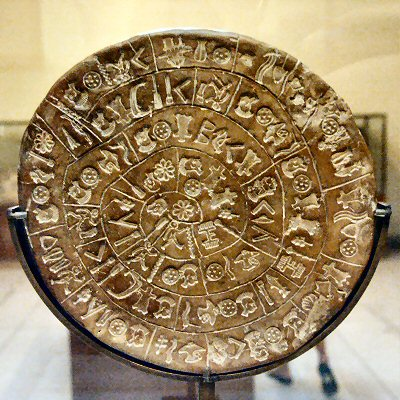
It is a disk of baked clay with inscriptions on both sides, dating to the late Bronze Age. It was discovered in July 1908 by the Italian archaeologist Luigi Pernier in the excavation of the Minoan palace of Phaistos, near Hagia Triad, in southern Crete. The purpose of use and its origin have not yet been determined, which has made this object one of the most famous mysteries of archeology. He is currently in the Heraklion museum in Crete. The inscription was made by pressing preformed hieroglyphic stamps on the soft clay, in a sequence spiraling towards the center of the disc. This was then cooked at high temperature. Some archaeologists assume that the writing of the disc of Festos is Minoan, but it is neither the linear A nor the linear B. Approximately 10 signs of the disc are similar to signs of linear writing. For that reason, other specialists attribute a non-Cretan origin to it. For example, according to the "protojónica" theory, the disc would be the work of a cycladic town.
TOP 11:
Maine Penny
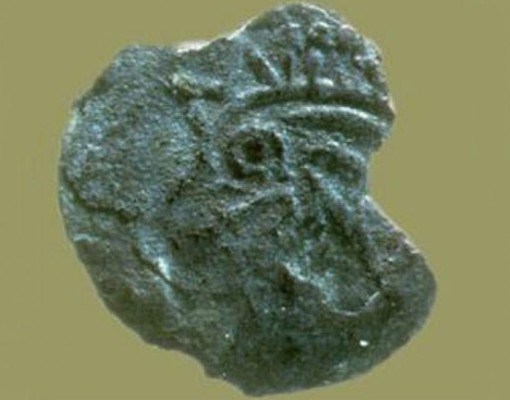
In 1957, archaeologists discovered in the ruins of the Indians in the State of Maine, United States, an authentic Norwegian penny whose history is remote at the beginning of the eleventh century. This discovery could corroborate that before the navigator Christopher Columbus, the Vikings of Northern Europe would have arrived in the south of Newfoundland.
TOP 10:
Map of Piri Reis
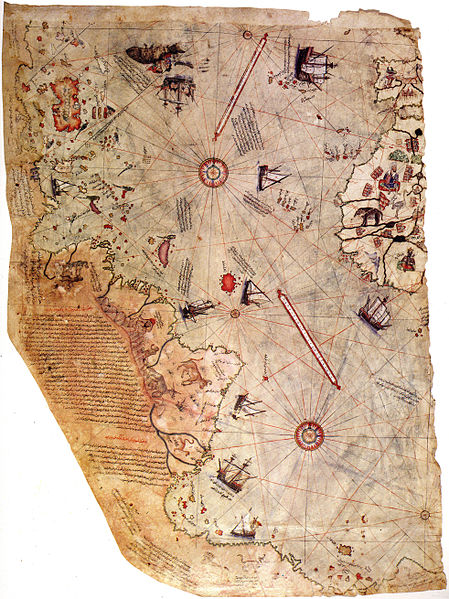
The map of Piri Reis is a fragment of a map prepared by the Ottoman admiral and cartographer Piri Reis in 1513. Piri Reis was born in Gallipoli in 1465. Nephew of a famous corsair, Kemal Re'is, from a very young age accompanied his uncle in his marine raids, participating in the naval campaigns against Venice and in the conquest of the island of Rhodes in 1523. Two years before this date he had published the Book of the Marine Matters, whose exhaustive information made reference exclusively to the Mediterranean.
TOP 9:
Dropa stones
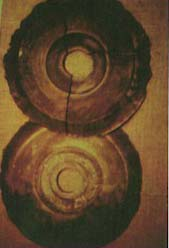
In 1938 a professor of archeology at Peking University and his students were on an expedition to explore a series of caves in the inaccessible mountains of Bayan Kara Ula, near Tibet. The caves seemed to have been artificially carved into a system of underground tunnels and pantries. While they were exploring the cave, they found a series of tombs and stone discs of an estimated age of 12,000 years. When the discs were examined by Dr. Tsum Um Nui, in Beijing around 1958, he concluded that each groove actually consisted of a series of tiny hieroglyphs of unknown origin and design. The rows of hieroglyphs were so small that a magnifying glass was necessary to see them clearly. Many of the hieroglyphics had been worn away by erosion.
TOP 8:
Stone spheres of Costa Rica
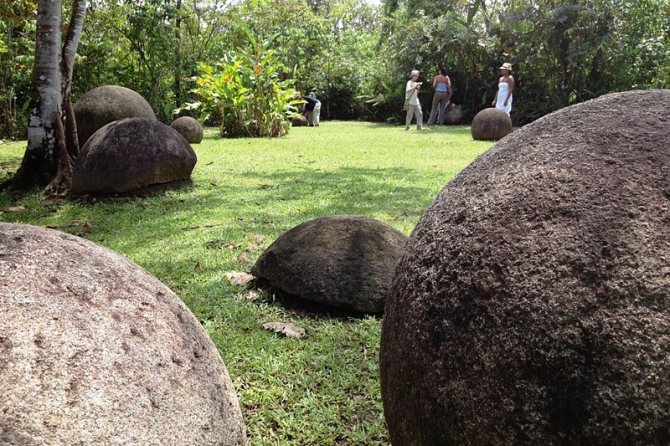
They are a group of more than five hundred petrospheres located mainly in the south of Costa Rica in the alluvial plain of the delta of the Diquís River (confluence of the Sierpe River and the Río Grande de Térraba), in the Osa Peninsula and in the Isla del Caño. The spheres are known locally as the "balls of Costa Rica". As a whole they are considered unique in the world for their number, size, perfection, formation of organized schemes and abstraction alien to natural models. The dimensions of the spheres oscillate in a range of 10 centimeters to 2.57 meters in diameter and their weight exceeds 16 tons. Most are made of hard stones such as granodiorite, gabros and a few in limestone. The archeologists through the stratigraphy of its location and other objects found in its vicinity, estimate that the stones were located by the natives of the area between 300 a. C. and 300 d. C., but sculptural work has not yet been scientifically dated. They have also been found next to objects of the type "polychrome ceramic of Buenos Aires" (1500-1000 BC) and it has been established that the area was inhabited at least from 6000 a. C .. 34 archaeological sites have been discovered, from the del Diquís delta in the south, the Isla del Caño to 17 kilometers from the coast, plains of the Pacific up to Papagayo, Golfo de Nicoya (300 km north of the river delta Diquís). Today hundreds of these small spheres are found in private collections and museums scattered around the world.
TOP 7:
Quimbaya artifacts
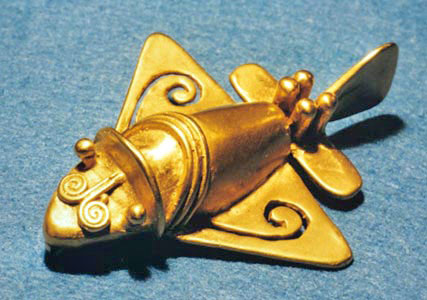
They are gold and bronze figures typical of the Quimbaya culture dating from around 1000 AD. C., found in Colombia. Some have been classified as ooparts, because although archaeologists believe they represent animals, others say they are more like modern airplanes that did not exist at the time. They were found near the banks of the Otún River (hence the ancient name of Otún birds). They are currently exhibited at the Gold Museum in Bogotá, but presented as zoomorphic figures and not as old planes. 24 of these figures are known, although many more have been found, but many of these have left the country illegally.
TOP 6:
The Texas Hammer
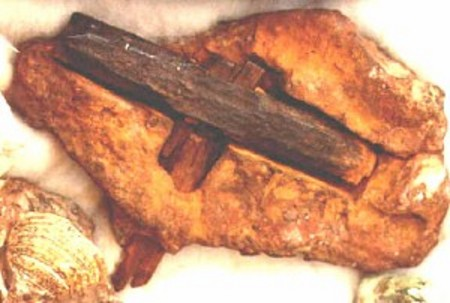
In the year 1934 or 1936 (there are doubts about the date) a couple, Mr. and Mrs. Max Hahn, found while hiking, a rock that jutted out of a wooden stick, on the bank of a stream in the outskirts of the town of London (Texas). Already the origin of the finding is involved in some doubts. In principle, it is not known with certainty the exact location of the find and the bedrock, if any, from where the rock containing the hammer would have been extracted. The lack of marks in the rock that surrounds the artifact makes experts think that it was found loose, without belonging to or forming part of a larger rock or being stratified. With this, despite what Baugh and his collaborators say, there is no evidence of any kind nor can it be proved that the rock was part of any stratum, and therefore, estimates of its antiquity (Ordovician for Baugh. Walter Lang and Bartz), have no basis on which to settle.
TOP 5:
Ship of Toprakale
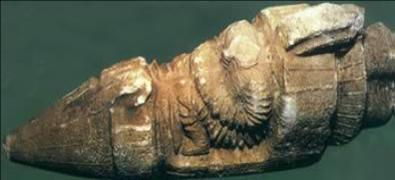
This impressive figure has the appearance of a manned spacecraft and was found in the ancient ruins of Tuspa, in Turkey. Its antiquity is estimated in about 3000 years. You can distinguish perfectly the cockpit of the ship with the pilot inside (which lacks the head) and a rear propulsion system.
TOP 4:
Microscopic objects from Narada
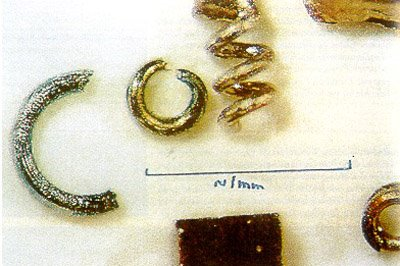
In the years 1991-1993, gold explorers from the small Narada River, on the eastern side of the Ural Mountains, have found unusual spiral metal objects. The size of these things ranges from a maximum of 3 cm to a minimum of 0.003 mm. So far, these unexplained artifacts have been found in several places near the Narada, Kozhim, and Balbanyu rivers, and also in the Vtvisty and Lapkhevozh tributaries, especially at depths of between 3 and 12 meters. They are composed of several metals: the largest are copper, while the microscopic ones are tungsten and a rare metal called molybdenum. Tungsten has a high atomic weight and is also very dense, with a melting point of 3410 ° C. Currently tungsten is used mainly for the hardening of special steels, and pure form for the filaments of light bulbs. Molybdenum also has a high density, and a melting point of 2650º C. This metal is also used to harden steels and give them corrosion resistant properties, it is also used mainly to make armor in military vehicles. All the tests carried out so far give an age for objects between 20,000 and 318,000 years.
TOP 3:
Voynich manuscript
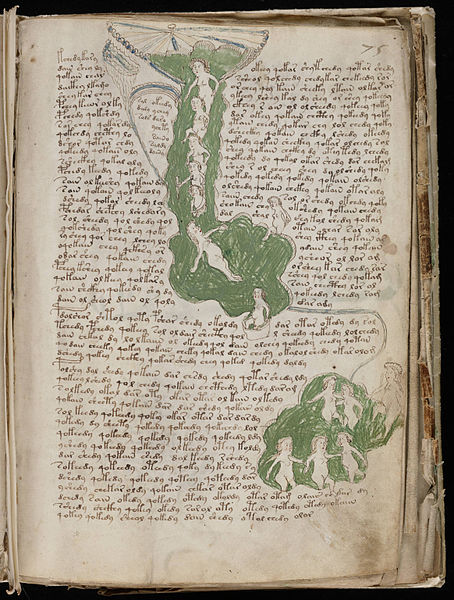
It is a mysterious illustrated book, of unknown contents, written about 500 years ago by an anonymous author in an unidentified alphabet and an incomprehensible language. Throughout its proven existence, the manuscript has been the subject of intense studies by numerous professional and amateur cryptographers, including leading American and British specialists in deciphered World War II. Nobody could figure out one single word. This succession of failures has turned the manuscript into the Holy Grail of historical cryptography, but at the same time it has fed the theory that the book is nothing more than an elaborate deception, a random sequence of symbols without any meaning. However, the one that complies with Zipf's law, according to which in all known languages the length of words is inversely proportional to their frequency of appearance (the more times a word appears in a language, the shorter it is), that it is not only a text written in a specific language, but also that this language is based on some natural language, since artificial languages such as Tolkien elves or the Star Trek Klingon do not comply with this rule. This is because the explanation for this law is based on linguistic economics: the words we use the most are shorter and thus require less energy, so it is the use of a language that ends up imposing this law. It is practically impossible for the author of the Voynich manuscript to know Zipf's law, enunciated many centuries later, and therefore to apply it to a language invented by him.
TOP 2:
Astronaut of Kiev
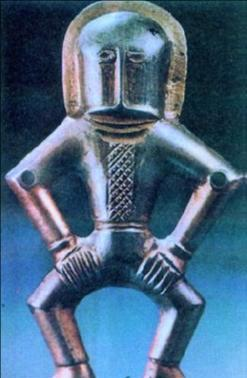
It is a 2,000-year-old metal statuette dressed in a strange metallic suit and helmet. I could not get more information about this enigmatic statue but I found it interesting.
TOP 1:
Antikythera Mechanism
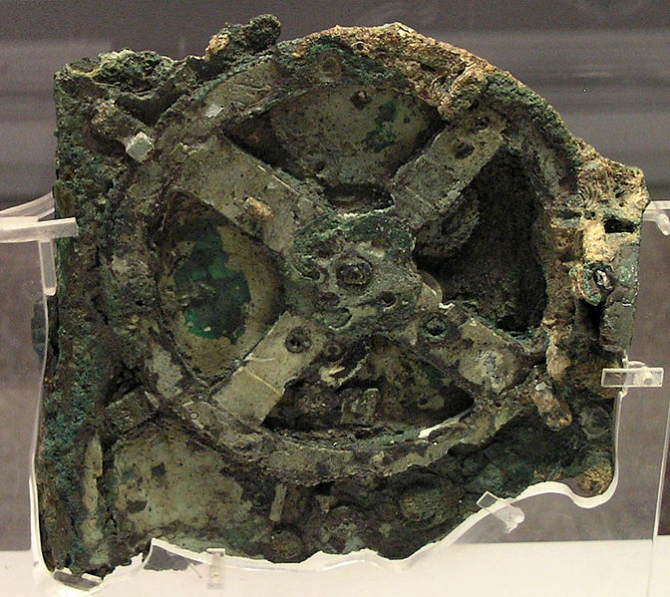
The Antikythera mechanism is an ancient mechanical calculator designed to calculate the position of the Sun, the Moon, and some planets, making it possible to predict eclipses. It was discovered in the wreckage near the Greek island of Anticitera, between Cythera and Crete, and is believed to date from 87 BC. C. It is one of the first known gear mechanisms, and was designed to follow the movement of celestial bodies. According to the reconstructions carried out, it is a mechanism that uses differential gears, which is surprising given that the first known cases until its discovery date back to the 16th century. According to the initial studies carried out by the historian Derek J. de Solla Price (1922-1983), the device was an astronomical computer capable of predicting the positions of the Sun and the Moon in the zodiac, although later studies suggest that the device was much more "intelligent". Using linear tomography techniques, Michael Wright, specialist in mechanical engineering at the Museum of Science in London, has made a new study of the artifact. Wright has found evidence that the Antikythera mechanism could reproduce the movements of the Sun and Moon accurately, using an epicyclic model devised by Hipparchus, and of planets such as Mercury and Venus, using an epicyclic model derived from Apollonius of Pergamum. However, it is suspected that part of the mechanism could have been lost, and that these additional gears could have represented the movements of the other three planets known at the time: Mars, Jupiter and Saturn. That is, he would have predicted, with an appreciable degree of precision, the positions of all known celestial bodies at the time.


